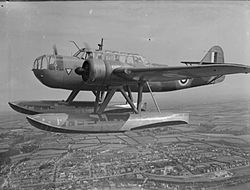| No. 320 (Netherlands) Squadron RAF | |
|---|---|
 A Fokker T.VIII of No. 320 Squadron begins a patrol after taking off from Pembroke Dock, Wales | |
| Active | 1 June 1940 – 2 August 1945 |
| Country | |
| Allegiance | |
| Branch | |
| Type | Inactive |
| Part of | RAF Coastal Command RAF Bomber Command RAF Second Tactical Air Force |
| Nickname(s) | Netherlands |
| Motto(s) | Latin: Animo libre dirigimur ("We are guided by the mind of liberty") Dutch: ("Wij worden geleid door een vrije geest") |
| Insignia | |
| Squadron Badge | In front of a fountain an orange tree fracted and eradicated. [1] The orange tree refers to the squadron's connection with the Netherlands and the fountain to its operations over the sea. [2] |
| Squadron Codes | SP (allocated June 1939 – Sep 1939) TD (Jun 1940 – Oct 1940) NO (Oct 1940 – Aug 1945) |
No. 320 (Netherlands) Squadron RAF was a unit of the Royal Air Force during World War II formed from the personnel of the Royal Netherlands Naval Air Service.
